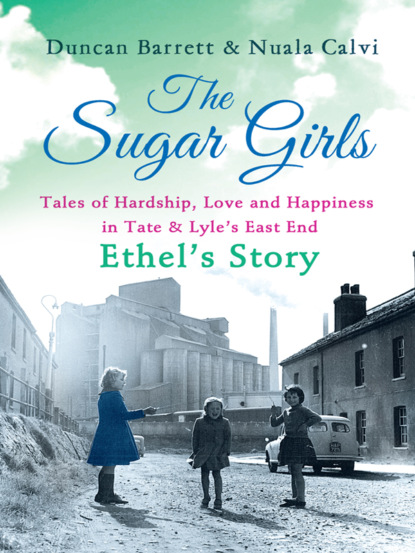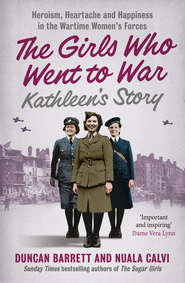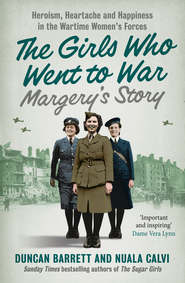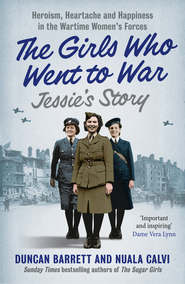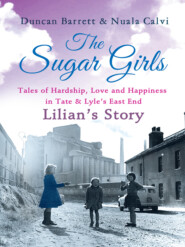По всем вопросам обращайтесь на: info@litportal.ru
(©) 2003-2024.
✖
The Sugar Girls – Ethel’s Story: Tales of Hardship, Love and Happiness in Tate & Lyle’s East End
Настройки чтения
Размер шрифта
Высота строк
Поля
At 14, Ethel had never been inside a factory, but she felt as if she’d been preparing for this moment all her life. She had grown up in the heart of Silvertown and was used to living in the shadow of the Sugar Mile – the stretch of colossal factories that ran between Tate & Lyle’s sugar and syrup refineries. The factory life was in her blood – her mother’s family had lived in the area for generations, working in Keiller’s jam and marmalade factory, and her grandfather would tell anyone who would listen that he remembered when Silvertown was little more than a marsh.
From a hut on the left of the entrance emerged a fierce-looking man in the smart, military-style uniform of a commissionaire, his navy-blue tunic buttoned up to the collar and the silver buttons gleaming in the sunlight.
‘Yes, darlin’?’
Ethel drew herself up to her full height and did her best to hide her nerves. ‘I’m here about a job,’ she told him.
‘In here.’ He gestured for her to follow him into the little hut.
Inside, Ethel stood anxiously while a man in a white boiler-suit glanced over her testimonial and noted down a few details on a form. ‘Hesser Floor, I reckon,’ he told her briskly, ‘but the surgery will need to check you out first. I’ll get a girl to take you.’
Before long a smartly dressed young woman who looked to be in her late teens arrived at the door. ‘Hesser girl?’ she asked Ethel, as they stepped out of the hut.
‘Um, I think so,’ Ethel replied, ‘but I’m not sure what that means.’
‘Oh, Hesser of Stuttgart make the sugar-packing machines, but we try to keep that quiet these days! Come on.’
The two girls headed into the refinery.
Ethel was quite unprepared for the sight that met her eyes. She knew that the factory was big, but seeing it up close, from the inside, was another matter. Ahead of her, slightly to the right, the enormous grey-brick hulk of the Hesser building towered over her. At its base a team of boys and burly-looking girls were standing on a raised level open to the yard, loading up great haulage lorries with tonne-weight boards of sugar bags. To her left, another large building housed the factory’s bar and Recreation Room, and in front of her wagon tracks crisscrossed all over the ground, branching off straight ahead towards the syrup shed, where the Lyle’s Golden Syrup tins were filled. Underneath it was the Blue Room, where the sugar bags were printed, and beyond was the can-making department, where girls produced the famous tins. In the distance she could make out the looming white concrete of the pan house, where sugar liquor was boiled into crystals, and next to it an even taller set of chimneys from the boiler house.
Ethel searched in vain for the shining curve of the Thames, where the boats of raw sugar were unloaded. She knew it must be at the far end of the site, but through the jungle of warehouses in between she couldn’t catch a glimpse of the water.
As the two girls hurried across the yard, a musty, malty smell of damp sugar hit them in a cloying wave – shortly followed by another, ranker odour that almost made Ethel retch. She knew what it was, but tried her best not to think about it: the pile of rotting carcasses just the other side of the factory wall, at John Knight’s soap works. It was a smell that every Tate & Lyle worker had to learn to ignore.
In the surgery, a young nurse listened to Ethel’s heart, took her blood pressure and checked the movement and strength of her limbs. Then she carefully scoured her frizzy hair for nits, before passing her fit for service.
Ethel followed the other girl back towards the dark-grey Hesser building, on the outside of which a black metal staircase zigzagged up all eight floors. ‘It’s a long way up but you get used to it,’ said the girl, as they began to climb the steps.
As they neared the top, Ethel was beginning to lose her breath, so she was relieved to spot a sign that read: SMALL PACKETS. They went into a cloakroom, where Ethel deposited her coat and bag, and then through a pair of double doors onto the factory floor.
The noise as they stepped through the doors was overwhelming. The large room echoed with the rattle and grind of a dozen machines, huge lumps of iron around which stood teams of young women. Over the top of the noise there was music blaring out, and some of the girls were singing along.
They went up some stairs to an office on a mezzanine level, and as the door clicked shut behind them Ethel was aware of a blissful quiet settling around her. The girl left her in front of an impeccably tidy desk on which stood a little sign: IVY BATCHELOR, FORELADY. Behind the desk sat a tall, upright woman in a long white coat. Her brown hair had evidently been expertly styled, and her nails and make-up were immaculate.
‘Take a seat,’ she said calmly, gesturing to a chair on the other side of the desk.
Ethel did so, sitting up as straight as she could. She was determined to make a good impression.
The forelady looked at her kindly, reached for a form from a pile on her desk and took down Ethel’s name and address. ‘Is there any particular reason you want to work at Tate & Lyle?’ she asked.
Ethel hesitated. She had dreamed of working at one of the giant sugar factories ever since she was little and her dad had taken her to the Tate Institute, the social club opposite the Thames Refinery. They had gone to see a show laid on for local residents and employees, and Ethel had been transfixed – not merely by the dancers onstage, but by the glamorous young women who thronged the hall watching them. They were the factory’s female workforce and her dad had told her they were known as the sugar girls.
She felt self-conscious at the idea of telling that story, though. ‘I only live down the road,’ she offered instead.
Ivy Batchelor laughed gently. ‘Now, I’m afraid we can’t offer you a uniform at present, unless you have ration coupons to spare, but we should be able to lend you an apron for the day.’ She rummaged around under the desk and came up with a rather worn-looking pinny. ‘Your hours are eight to four Monday to Friday and eight to twelve on Saturday. You’re allowed half an hour for dinner and two toilet breaks a day. Any questions?’
Ethel shook her head.
‘Good. Then Mary will see you to one of the machines.’
As if on cue, a stern-looking woman with dark hair marched through the door of the office and gestured for Ethel to follow her. She was Mary Doherty, one of the department’s three supervisors, known as charge-hands.
‘This way,’ she commanded. Ethel jumped up and followed her onto the floor.
At each machine, paper bags were moving along a conveyor belt and being filled with sugar from a chute overhead. They were then sealed with a spurt of glue and a girl took them off the belt, piling them up ready to be packed. A packer then pulled down a sheet of brown paper and flipped the bags onto it in layers until they had made up a parcel, sealing it like an envelope with a bit of cold water and heaving it onto a board. When a tonne-weight of sugar had been assembled, it was taken away on a trolley down to the lorry bay. In charge of each machine was a driver, who paced around keeping an eye on everything. The girls’ various repetitive movements combined to give the impression of an elaborate ballet.
Mary led Ethel across to a machine at the far side of the room, where a woman with giant hands was parcelling up the sugar bags.
‘This is Annie Stout,’ Mary told Ethel. ‘She’ll show you how the packing is done.’ She strode off across the floor and back up to the office.
Ethel noticed that on the ends of Annie’s fat fingers were ten little paper thimbles. ‘You’ll need some of these,’ she told her, ‘or your hands’ll be bleeding by lunchtime.’
Without once interrupting her flow, Annie instructed Ethel in how to make her own thimbles from some spare scraps of paper. Then she stood back and let her have a go at packing.
At first Ethel found it hard holding several bags at once in her hands, but if she applied enough pressure to the sides, and lifted them in a clear, fluid arc, twisting them rapidly before they had a chance to slip, she found that she could manage it without dropping any.
‘That’s it,’ Annie told her approvingly. After a while, she leaned in close and Ethel thought she was going to offer to take over the job again, but instead she whispered something in her ear.
‘Got any sweetie coupons you don’t want, darlin’?’
‘Any what?’ said Ethel, taken aback by the question.
Annie whispered more emphatically: ‘Ration coupons.’
‘No, sorry,’ Ethel replied briskly. She screwed up her face as if focusing intently on her work, and tried to avoid catching Annie’s eye.
Before long Ethel’s wrists were aching from flipping layer after layer of sugar bags, and she was beginning to wonder whether it was too soon to ask for one of her two toilet breaks.
Just then there was a sudden dimming of the lights, and a voice crackled out from the loudspeakers which were stationed around the room.
‘All personnel to shelters, please. All personnel to shelters.’
The driver of Ethel’s machine swiftly pulled a lever, and the whole mechanism ground to a halt. Carefully, Ethel laid down the bags in her hands to complete a layer, and then looked up, hoping that Annie would tell her what to do next. But Annie was gone, lost in the stream of bodies filing in an orderly but hurried fashion towards the exit.
Four years after the start of the Blitz, Tate & Lyle had got evacuations down to a fine art, and could gather 1,500 of their wartime workforce into shelters within the space of four minutes. A command centre under the can-making department received signals from the national telephone exchange, and four spotters permanently stationed on the pan-house roof provided visual confirmation. Those whose jobs meant that they couldn’t simply leave their posts – such as the men on the boilers and turbines, which were not easily shut down – were provided with blast-proof shielding to keep them safe, while the rest were immediately ordered to evacuate.
Ethel rushed to join the back of the queue of sugar girls streaming out of the door. It was only now that she heard sirens outside the factory as well.
In front of her was one of the smart girls from the office. ‘You’re new, aren’t you?’ she asked.
‘Yes, it’s my first day,’ said Ethel wryly.
‘Poor you!’ the other girl replied. ‘Well, don’t worry, the shelter’s just downstairs – we can’t have them underground because of the river. I’m Joanie, by the way. Joanie Warren.’
Ethel followed Joanie back down the black iron staircase to the second floor of the building. It was the same size as the Hesser room up above, but whatever machinery it had once housed had been removed, and blast walls had been built, dividing it into compartments. The windows were all bricked up, and wooden boards lined the floor for the workers to sit on. Ethel tried hard to suppress the feeling that she was cooped up in a dungeon.
Before long, the room was packed with bodies, mostly women and girls but a fair number of men as well. By now only a third of the refinery’s employees were male, and women who had previously been forced to leave when they got married were hurriedly being recalled by an army of door-knockers. Many had taken over jobs formerly held by men – working on the lorry bank under the Hesser Floor, manning the centrifuges and working as fitters in the can-making department. Others had been assigned a variety of unusual new roles: dehydrating vegetables to be sent out in tins to the troops (often with a hopeful note containing the name and address of the girl who had sent them) and even producing aeroplane and gun parts.





